Evergreen combos (mostly) for Austin
A local reader asked me about evergreen plants that grow well here in central Texas, and as I was putting together today’s Foliage Follow-Up post, I realized it’s a good opportunity to share some of my faves. I use a lot of evergreen plants — though not necessarily shrubs — because 1) they tend to require less maintenance than plants grown for flowers, 2) they look great year-round, 3) they provide wonderful structure, and 4) I have lots of shade, and flowers generally need more sun.
In the photo at top you see a chartreuse scrim of bamboo muhly (Muhlenbergia dumosa), an ornamental clumping grass that stays evergreen in most winters. Last winter’s two Arctic blasts did bleach out the foliage, and it takes its time in greening up again. But for a light-catching green cloud, drought tolerance, and deer resistance, this grass can’t be beat.
In the steel planter, ‘Burgundy Ice’ dyckia offers a dark-leaved evergreen option for Austin gardens. Again, it can be damaged in extreme cold, but most winters it does fine. As a low-growing, front-of-border plant, white skullcap (Scutellaria suffrutescens ‘White’) is a semi-evergreen sub-shrub that tolerates dappled shade. It looks best with a light shearing in late February and maybe again in mid-August. The white-flowering skullcap can be hard to find, but pink is readily available. Save the purple skullcap (Scutellaria wrightii) for full sun and gravelly conditions.
Here’s a long view of this same bed, from a little further along the driveway. Strappy Texas sotol (Dasylirion texana) is the star here, backed by bamboo muhly. In front, I just took out all my iris, which wasn’t blooming in the dappled shade, and replaced it with evergreens ‘Micron’ dwarf yaupon holly (Ilex vomitoria ‘Micron’), foxtail fern (Asparagus meyeri), and variegated flax lily (Dianella tasmanica ‘Variegata’). ‘Micron’ holly is a new one for me and is said to get only about 1-1/2 ft. tall by 2-1/2 ft. wide. (I bought all of Barton Springs Nursery’s supply, but I spotted it at The Natural Gardener last weekend.) Foxtail fern and flax lily both can be hurt by deep freezes, but generally they do fine in Austin’s winters, and they are workhorses that require very little care or maintenance.
‘Green Goblet’ agave (Agave salmiana var. ferox ‘Green Goblet’) is a winter-hardy agave with a beautiful olive-green leaf with a tinge of blue. It produces pups on underground runners, but not too many, so they’re manageable. I just tug it loose whenever one pops up — usually several feet away from the mother plant. The silver groundcover woolly stemodia (Stemodia lanata) is not evergreen, but it’s a good choice for part or full sun and gravelly conditions. Fuzzy-leaved mullein (Verbascum spp.), which is generally evergreen for two years until it blooms and then dies, grows amid the stemodia.
In the background, I’m growing a lawnette of evergreen Berkeley sedge (Carex divulsa). I now recommend ‘Scott’s Turf’ sedge (Carex retroflexa ‘Scott’s Turf’) instead of Berkeley (Scott’s is less fussy), but both are good lawn substitutes for part shade or dappled shade and green all year.
Purple-leaved ‘Vertigo’ grass (Pennisetum purpureum ‘Vertigo’) goes brown and dormant after a freeze, but it does return each year, unlike traditional purple fountain grass. Next to it, lavender-flowering Mexican oregano (Poliomintha longiflora) has fragrant, edible, evergreen leaves. You can see the evergreen sedge lawnette in the background.
My favorite agave has to be whale’s tongue (Agave ovatifolia), a powder-blue agave that doesn’t pup but grows in an open, rose-like form. I also like evergreen softleaf yucca (Yucca recurvifolia), growing at left of the agave — and too close, unfortunately. In the foreground, blooming hot pink and attracting hummingbirds, is autumn sage (Salvia greggii). Its tiny, semi-evergreen leaves release a minty fragrance when you crush them or brush against them.
I also love wide-leaf giant hesperaloe (Hesperaloe funifera ssp. chiangii), a stately, more open and vase-like relative of the common red yucca. Its evergreen leaves are long and sword-like, although not particularly spiny, and white thread-like fibers dangle from their edges. A white-flowering Turk’s cap (Malvaviscus arboreus var. drummondii ‘Alba’) grows in front — not evergreen, but a nice companion in dappled shade. The white Turk’s cap is harder to find than the common red, but last week I saw some 1-gallons for sale at Barton Springs Nursery.
The only downside of using giant hesperaloe is that bucks love to rub their antlers on it in the fall and winter, smashing its beautiful form. So now I put rolled wire fencing around it from early fall through spring. And I do the same with my ‘Green Goblet’ agave, which the bucks will also antler-damage.
The side-yard path into the back garden is mostly evergreen with bamboo muhly, ‘Blue Ice’ Arizona cypress (Cupressus arizonica var. glabra ‘Blue Ice’), ‘Sapphire Skies’ Yucca rostrata, ‘Will Fleming’ yaupon (Ilex vomitoria ‘Will Fleming’), ‘Bright Edge’ yucca (Yucca filamentosa ‘Bright Edge’), and prickly pear (Opuntia).
I’m loving the totem-pole shape of my one surviving Indian fig opuntia (Opuntia ficus-indica). The others succumbed to a deep freeze one year. Indian fig is less cold tolerant than many prickly pears.
Peeking around the Yucca rostrata, you see a couple more hardworking evergreens, ‘Winter Gem’ boxwood and the ubiquitous live oak (Quercus fusiformis), which shades most of my garden and indeed most of my neighborhood, none of which were planted by human hands and grow as Mother Nature planted them in loose clusters.
This is my September post for Foliage Follow-Up. Fellow bloggers, what leafy loveliness is happening in your garden this month? Please join me in giving foliage its due on the day after Bloom Day. Leave a link to your post in a comment below. I’d appreciate it if you’ll also link to my post in your own — sharing link love! I look forward to seeing your foliage faves.
I welcome your comments; please scroll to the end of this post to leave one. If you’re reading this in a subscription email, click here to visit Digging and find the comment box at the end of each post.
_______________________
Digging Deeper: News and Upcoming Events
Get ready for fall garden tours in Texas! The Garden Conservancy is sponsoring Open Days tours in Fort Worth on Oct. 8th, San Antonio on Oct. 14th, and Austin on Nov. 4th.
Get on the mailing list for Garden Spark Talks. Inspired by the idea of house concerts, I’m hosting a series of garden talks by talented designers and authors out of my home. Talks are limited-attendance events and generally sell out within just a few days, so join the Garden Spark email list for early notifications. Simply click this link and ask to be added.
All material © 2006-2017 by Pam Penick for Digging. Unauthorized reproduction prohibited.


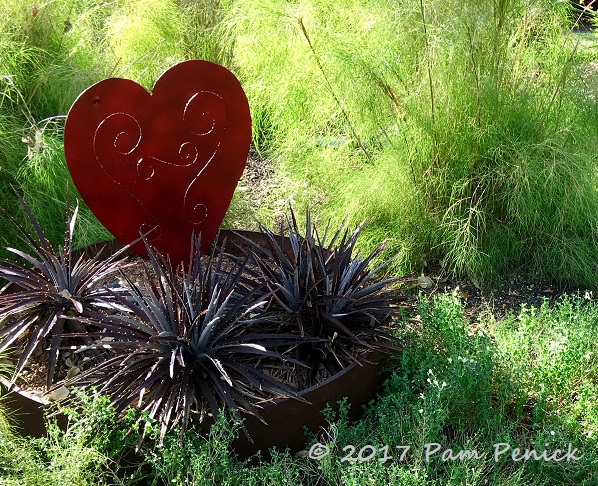
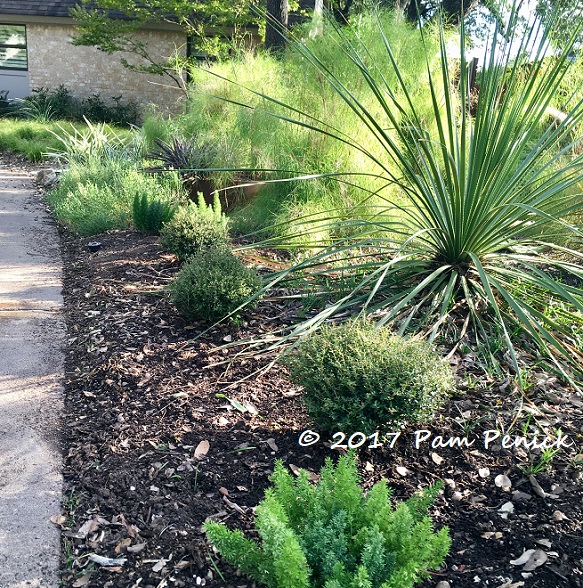
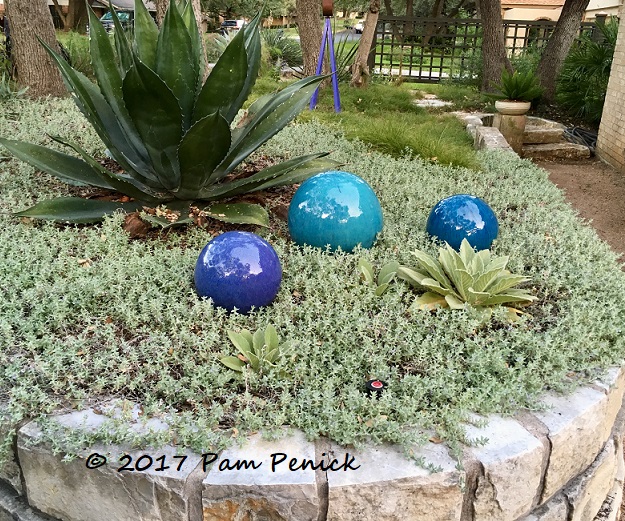
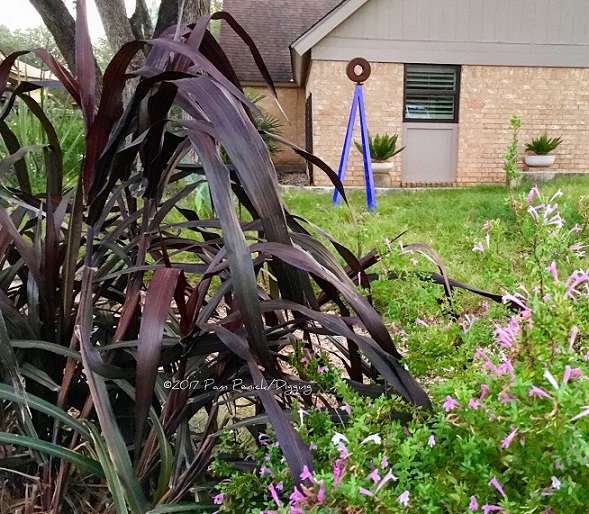
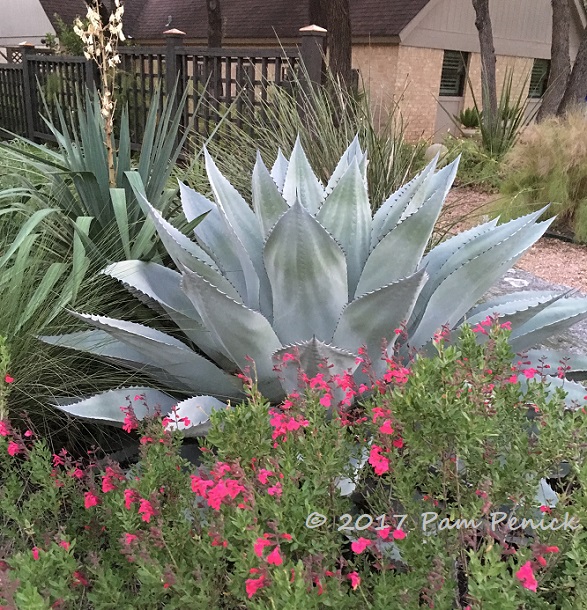
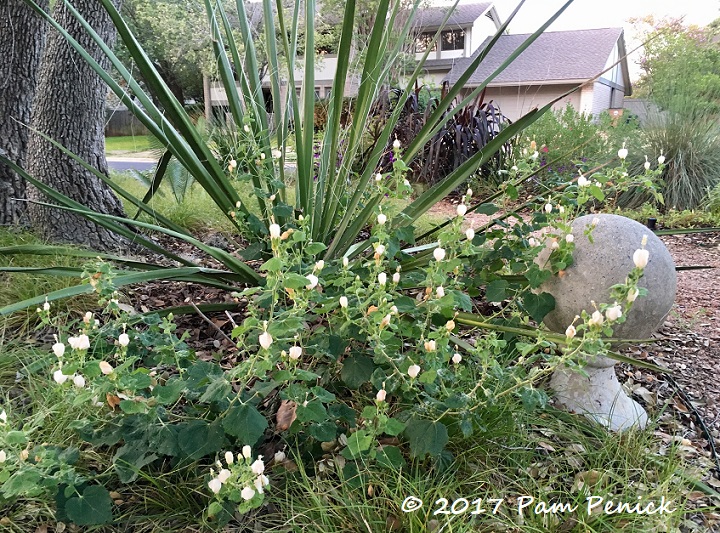
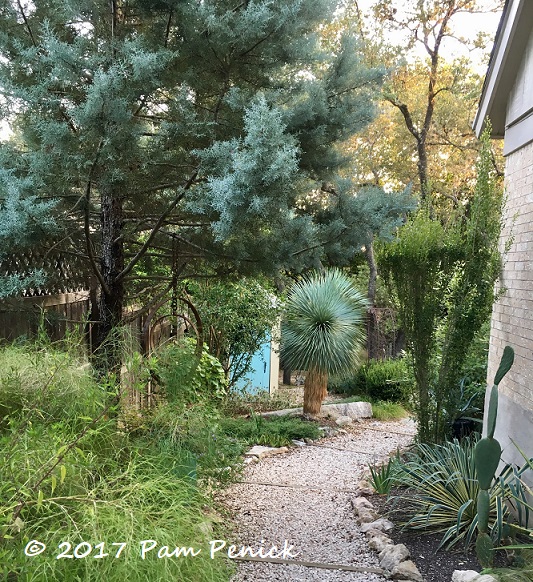
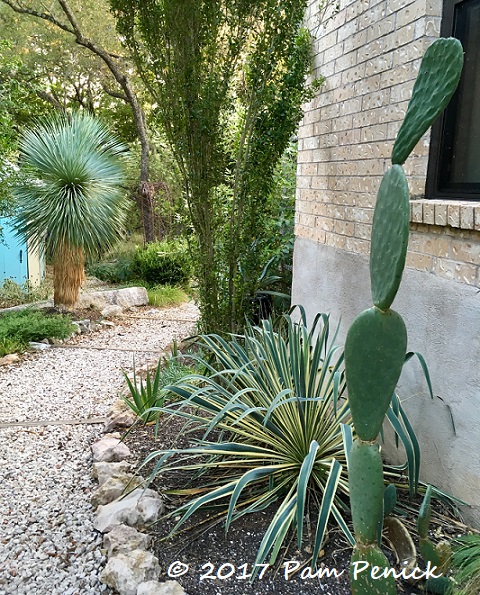
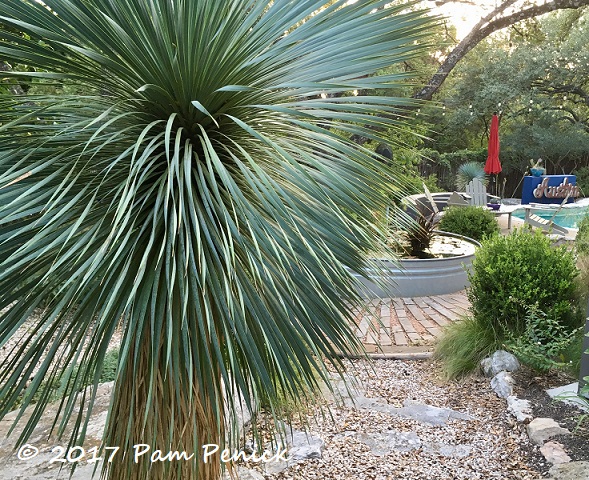
You showed some of my favorites in your garden. Of course I can’t grow hardly any of them but I love looking at them. The little Moby’s that you sent are growing this summer. They still are very small but It is fun watching them grow. I wonder what I will do with them when they get too big to carry inside for winter. Oh well, I will deal with that when it happens. I would love to have one of those Yucca rostratas too. That would look cool sitting in my garden. Yet again, what would I do with it during winter??? ha
Yucca rostrata is pretty cold hardy, Lisa, up to Zone 5 provided it has excellent drainage. Maybe you CAN grow it. —Pam
I love all these evergreen plants, especially the agave in that sea of silver green groundcover. My foliage followup is at: https://plantgeeksgarden.blogspot.com/2017/09/foliage-follow-up-september-2017.html
Somehow I always think everything there is evergreen! My foliage is here: http://www.lindabrazill.com/each_little_world/2017/09/foliage-follow-up-9162017.html
I have a foliage follow up.
https://greenbowgardens.blogspot.com/2017/09/foliage-follow-up-september-2017.html
This is a nice collection of evergreen plants. The Muhlenbergia dumosa) looks very similar to mondo grass, which we grow here in northeast. Nice shares. Here is my Foliage Follow Up post: http://landscapedesignbylee.blogspot.com/2017/09/garden-bloggers-bloom-day-foliage.html#.Wb2tObJ96Uk
Muhlenbergia dumosa is a lot bigger than mondo grass — about 4-5 feet tall and wide — and shaggy. I do love seeing all the different kinds of grasses out there. —Pam
Great combinations, as always, Pam! I really like the Foxtail Ferns–I noticed quite a few of them in Florida near my parents’ winter home. Then I started noticing people here in the north growing as annuals. The combination with the holly and the bamboo muhly is nice, as is the Stemodia/Agave combination. Really pleasant! Thanks for hosting! https://plantpostings.blogspot.com/2017/09/flower-and-foliage-vignettes.html
Your garden is looking great, Pam! I’m still looking for a Yucca rostrata here – I found one available by mail order but, shipped in a 4-inch pot, I expect I’d be waiting a VERY long time before it looked as lovely as yours. Here’s my foliage follow-up post: https://krispgarden.blogspot.com/2017/09/foliage-follow-up-first-signs-of-fall.html
What?! Is Yucca rostrata not commonplace in L.A., as it is here? I am sure it would grow beautifully in your climate. Yeah, don’t buy a teeny-tiny one via mail order. It grows slowly, although regular water (provided it has excellent drainage) will speed things along. —Pam
From A Shovel-Ready Garden: http://shovelreadygarden.blogspot.com/2017/09/september-chard-for-foliage-follow-up.html
Hi, new to your site but not to Austin or gardening. Love your blog! hope its ok to share a bit, have had success with crinum for evergreen foliage & bonus showy fragrant flowers. Once established several types are pretty drought hardy. surprised local nurseries dont really carry them. My neighbor & gardening buddy collects them, & we take “field trips” to nurseries in Houston & San Antonio where they are widely available. Also have gotten them from her & other friends which is always the most fun way to get a new plant! Historic irises also drought friendly, evergreen, tough & multiply readily. There is even a category of iris called Arilbred (middle east types crossed with european types) that is very well suited to dry areas.
It’s definitely OK to share, kkatx. Thanks for pointing out that crinums can be a good evergreen choice for Austin gardeners. I always think of crinums as thirsty plants since I grow one in my pond. I didn’t realize they could be drought hardy! Or evergreen, for that matter. —Pam